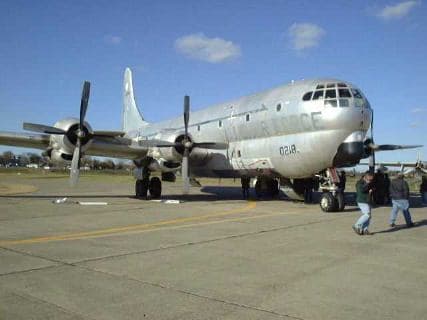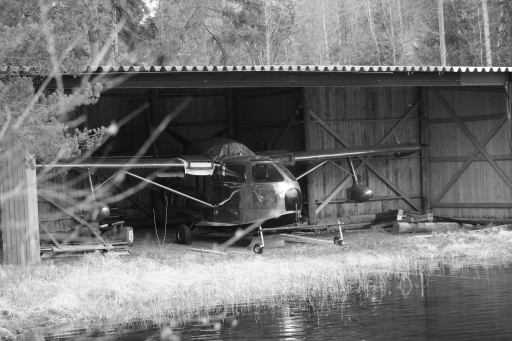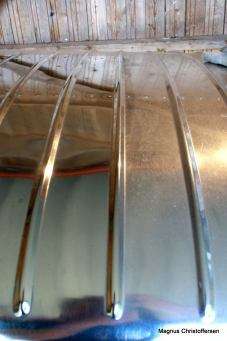
-----
Cleaning anodized aluminium on 1950's aircraft
2000
How would one clean 18 years of crud and streaks off of a Boeing
337 Stratocruiser (actually a KC-97G)?
The aircraft has been sitting outside for 18 years in WY. It is now at the Minneapolis St Paul Airport after its only flight in 18 years on 3 Nov 2000.

The skin of the aircraft appears to be shiny aluminium - I assume anodized - and I do not want to damage it in any way as we try to clean it. But it has lots of white streaks so dirt, salts (acid rain?), and other deposits. You can actually feel the height of the streaks on the lower part of the fuselage.
What will cut the dirt and streaks to restore the shine without cutting the surface of the skin? Is
"Nevr-Dull
⇦ on
eBay or
Amazon [affil link]
" safe on this skin? Is there specific cleaners for this type of aircraft skin?
Thanks for any advice and help.
- Minnetonka, Minnesota USA
If you can feel the surface imperfections you are describing, then you cannot clean it away. Mechanical buffing and polishing methods + re-anodizing is pretty much the only way to restore the finish to a semi-new look.
Matthew Stiltner- Toledo, Ohio
2001
You might try some of the corrosion removers from Cortec. It will make buffing easier afterward because it will remove the hard layer. The aluminum oxide that forms the streaks is very hard and abrasive. You also need to be treating the areas that are under the rivet heads, in seams and faying surfaces. That is where most of your corrosion is starting. The Cortec products will leave a vapor corrosion inhibitor in these areas to reduce the possibility of further corrosion damage. Using their VCI 415 Aircraft wash
(Specified by the Coast Guard) will also help keep the bird from corroding.
You have to do everything you can to inhibit corrosion on these aircraft because it is very expensive to fix them if you don't. I have a friend with a B25 that just found out how expensive it can be.
- Streamwood, Illinois
2001
Do you know what squadrons that KC-97G 53-0218 belonged to? I have a website with old color photos of KC-97s in action. You can see what the metal used to look like. E-mail me at kcboomer@pacbell.net to get the information.
Jim WebbUSAF - Travis AFB, California
2001
In answer to the question of what units 218 belonged to. Aircraft 218 was assigned to the 384th AREFS Westover AFB, Mass from Oct 1955 thru at least May of 1962. It was assigned in block number aircraft 53-0218 thru 0239. Can see this info at KC 97f then down to 4050th ARW Westover.
Ed Townsend- Summit Station, Ohio, USA
2006
I have a Seabee RC-4 from 1947 with an aluminium finish (unpainted)
It has corrosion or aluminum oxide which has left hard resistant white streaks and/or spots on the surface which is very difficult to remove. I have used products such as Permagard both abrasive cleaner and non abrasive which works without cutting too deep into the bare metal but the traces reappear after a while.


How and what can I do to prevent this further? my understanding is to use wet sandpaper like on boats and cut the first layer of oxidation and protect it straight away to prevent and slow down the reaction of oxidation.
aircraft restorer - Karlstad, Sweden
June 2, 2011
Try next webpage tighar.org/Projects/Histpres/guide.html. I think that you must use some sort of protective finish too (phosphate, or chromate based + clearcoat). Hope it helps and good luck!
Goran Budija- Zagreb, Croatia
June 7, 2011
Q, A, or Comment on THIS thread -or- Start a NEW Thread